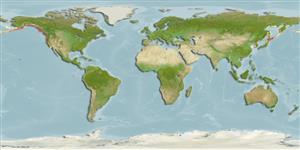>
Perciformes/Zoarcoidei (Eelpouts and pricklebacks) >
Scytalinidae (Graveldivers)
Etymology: Scytalina: Greek, skytale, -es = branch; cylindrical piece of wood used by Spartan army, with a paper tied around it containing orders or comunnications from the courts. It is also a kind of fish (Ref. 45335).
More on authors: Jordan & Gilbert.
Environment: milieu / climate zone / depth range / distribution range
Ekologi
laut dasar (demersal). Temperate
Eastern Pacific: Bering Sea coast of Alaska to Diablo Cove, central California, USA.
Size / Weight / umur
Maturity: Lm ? range ? - ? cm
Max length : 15.0 cm TL jantan/; (Ref. 2850)
Duri punggung (Keseluruhan (total)): 0; duri punggung lunak (Keseluruhan (total)): 41-51; Duri dubur 0; Sirip dubur lunak: 36 - 41. Caudal rounded. Pectorals small.
Found in rocky areas, tide pools and off beaches (Ref. 2850). Burrows in loose gravel and sand or among broken shells on the bottom (Ref. 2850). May not utilize the intertidal zone for reproductive and recruitment purposes (Ref. 56899).
Life cycle and mating behavior
Kematangan | Reproduksi, perkembang biakan | Pemijahan | telur-telur | Fecundity | Larva
Eschmeyer, W.N., E.S. Herald and H. Hammann, 1983. A field guide to Pacific coast fishes of North America. Boston (MA, USA): Houghton Mifflin Company. xii+336 p. (Ref. 2850)
Status IUCN Red List (Ref. 130435)
ancaman kepada manusia
Harmless
penggunaan manusia
informasi lanjut
Nama-nama umumSinonim (persamaan)metabolismePemangsaEkotoksikologiReproduksi, perkembang biakanKematanganPemijahanSpawning aggregationFecunditytelur-telurpekembangan telor
Umur / SaizPertumbuhanpanjang-beratpanjang-panjangukuran frekuensiMorfometrikMorfologiLarvaDinamika larvapemulihanKelimpahanBRUVS
AcuanBudidaya airprofil budidaya airStrainGenetikaElectrophoresesDiturunkanPenyakit-penyakitPengolahanNutrientsMass conversion
mitraGambarStamps, Coins Misc.Suara-suaraCiguateraKecepatanTipe renangArea insangOtolithsOtakPenglihatan / visi
Alat, peralatan
laporan khas
muat turun XML
Sumber internet
Estimates based on models
Preferred temperature (Ref.
123201): 5.7 - 14.8, mean 9.8 °C (based on 220 cells).
Phylogenetic diversity index (Ref.
82804): PD
50 = 1.5000 [Uniqueness, from 0.5 = low to 2.0 = high].
Bayesian length-weight: a=0.00389 (0.00180 - 0.00842), b=3.12 (2.94 - 3.30), in cm total length, based on all LWR estimates for this body shape (Ref.
93245).
Trophic level (Ref.
69278): 3.3 ±0.5 se; based on diet studies.
Fishing Vulnerability (Ref.
59153): Low vulnerability (10 of 100).
